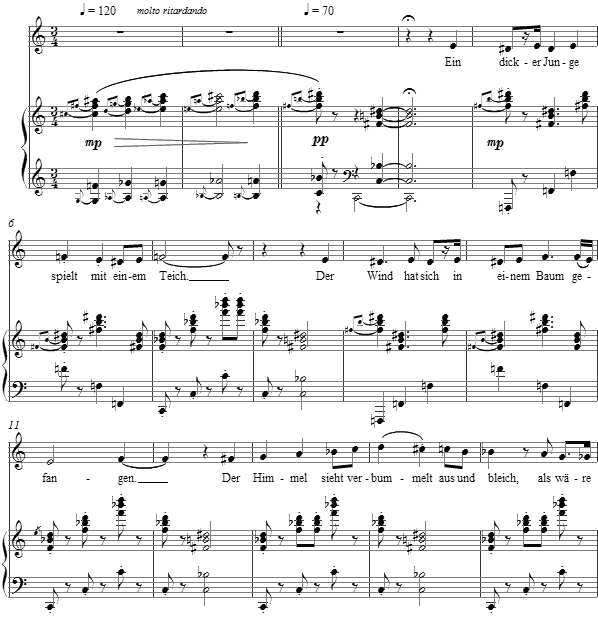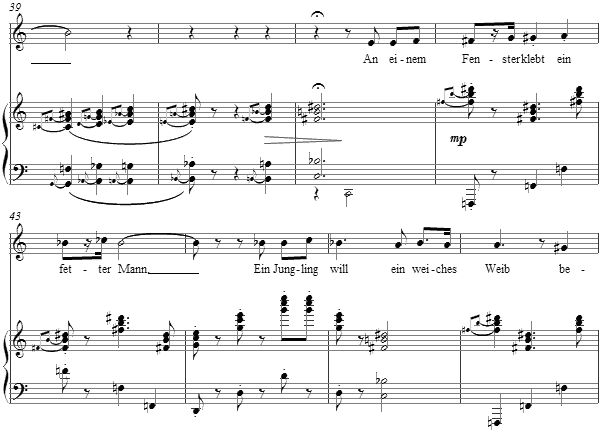Music and Texts of GARY BACHLUND
Vocal Music | Piano | Organ | Chamber Music | Orchestral | Articles and Commentary | Poems and Stories | Miscellany | FAQs
Die Dämmerung - (2009)
Alfred Lichtenstein
for medium or low voice and piano
Ein dicker Junge spielt mit einem Teich.
Der Wind hat sich in einem Baum gefangen.
Der Himmel sieht verbummelt aus und bleich,
Als wäre ihm die Schminke ausgegangen.
Auf lange Krücken schief herabgebückt
Und schwatzend kriechen auf dem Feld zwei Lahme.
Ein blonder Dichter wird vielleicht verrückt.
Ein Pferdchen stolpert über eine Dame.
An einem Fenster klebt ein fetter Mann.
Ein Jüngling will ein weiches Weib besuchen.
Ein grauer Clown zieht sich die Stiefel an.
Ein Kinderwagen schreit und Hunde fluchen.[ 4 pages, circa 3' 15" ]
Alfred Lichtenstein
Twilight
At a pond a smudgy pudgy boy played.
The wind had imprisoned itself in a tree.
The sky seemed overly pale and staid,
As if run out of make-up, aimlessly.
Bent over on crutches, long and crook'd,
Two blabbering cripples passed through the land.
A blond author was perhaps as crazy as he looked.
A pony tripped over a woman unplanned.
A fat man was stuck to his window sill.
A searching youth would seek his fair maid.
A gray-day clown pull up his boots for a thrill.
A pram was pushed along and the hounds bayed.
Rhymed paraphrase by the composer.
Alfred Lichtenstein (1889-1914) was a German lawyer and writer in the German Expressionist movement, born in Berlin-Wilmersdorf, and killed in World War One near Vermandovillers, Somme, France. The son of a manufacturer, Lichtenstein finished a study of law in Erlangen, and published poems and short stories in the fashion of a grotesque style, like that of his friend, Jakob van Hoddis. Lichtenstein wrote of this contemporary sense of malaise, "The only solace: be sad! If sadness becomes despair: be grotesque! Living on by joking, finding one's amusement by the acknowledgement that existence consists of sheer, brutal and shabby events." The notion of the Expressionist was to record personal perspectives of events, and this poem evidences a "portrait" of many seemingly insignificant details of a moment at dusk.
The five-note chords slipping chromatically upward by half steps surveys the whole tonal range of what the Second Viennese School sought in their ideological urges, that "liberation" of the twelve tones. In this short opening gambit, they are many times expressed. The sense of a tonal domain to the setting slips away as well, as the accompaniment for the first verse with its lingering on successive half steps is essentially polytonal.
The second verse does not follow the first except in general structure, but rises a step above it as the chromatic slipping allows easily. The vocal line exhibits some similarities to the first verse, but develops along its own path. The shift between lyrical liaisons and a brittle staccato punctuate the octave displacements.
The third verse returns to mimic the first but then turns away subtly, the vocal line rhythmically altered for the sense of the text.
The coda to the song drifts again through the five-note slip chords, which together with the polytonality of the accompaniment and the tonal wanderings of the vocal line portray one man's "expressionist" image at dusk in which the failing colors of sky darkly paint people for this moment in time.
The score for Die Dämmerung is available as a free PDF download, though any major commercial performance or recording of the work is prohibited without prior arrangement with the composer. Click on the graphic below for this piano-vocal score.




